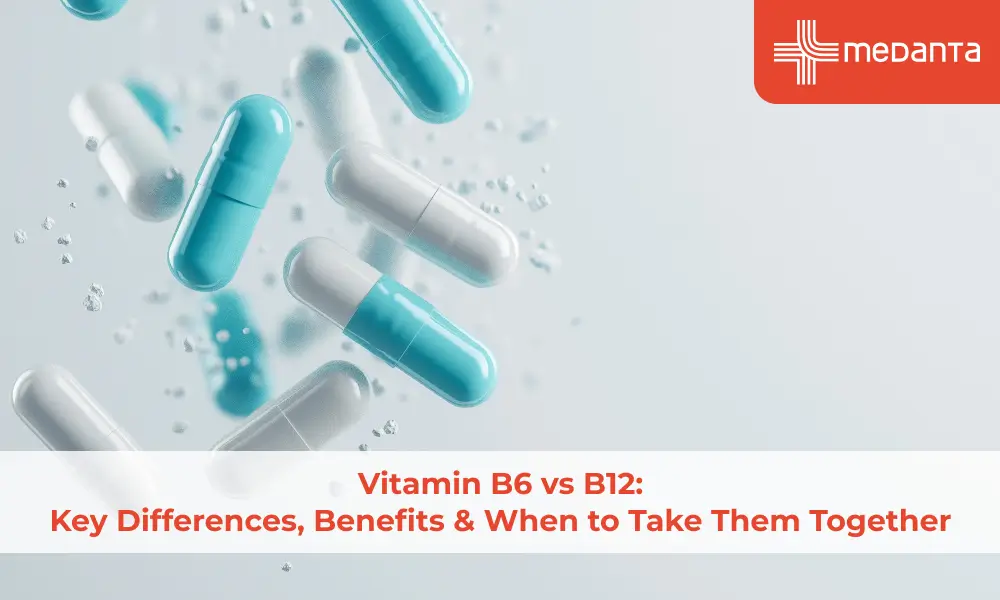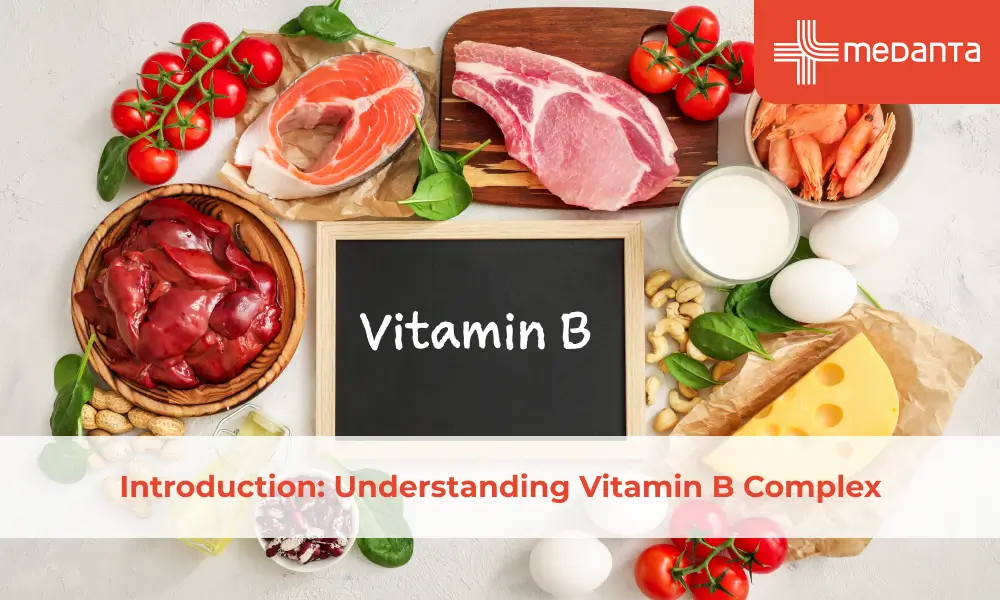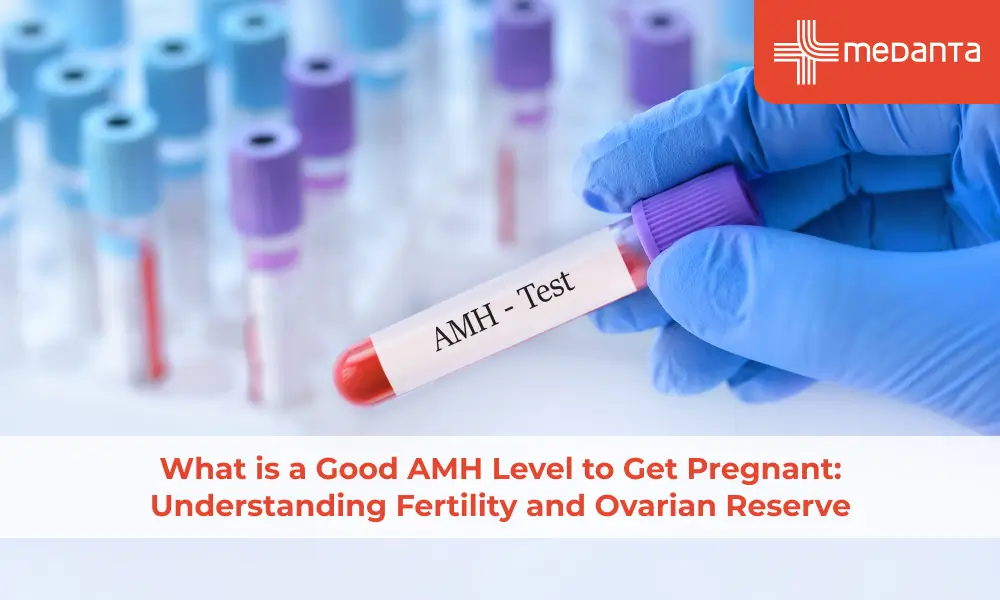Vitamin B6 vs B12: Key Differences, Benefits and When to Take Them Together

TABLE OF CONTENTS
- What Are B Vitamins?
- What Is Vitamin B6?
- Health Benefits of Vitamin B6
- What Is Vitamin B12?
- Health Benefits of Vitamin B12
- Common Food Sources of B6 and B12
- When to Think About Supplements
- Can You Take B6 and B12 Together?
- Key Differences Between Vitamin B6 and B12
- Symptoms of Deficiency in B6 and B12
- FAQs
Vitamin B6 and B12 play significant roles in keeping our bodies healthy, but they work in different ways. Vitamin B6 controls hormones and helps with more than 100 metabolic processes. B12 is necessary for nerve function & DNA synthesis. These nutrients are the foundations of the B vitamin family, and each provides unique benefits that work together.
The nervous system needs both of these vitamins to work properly. B6 helps send nerve signals effectively, while B12 focuses on growing new nerve fibres and repairing nerve damage. People can make better choices about their nutrition by understanding how these vitamins differ. Daily vitamin needs vary a lot - adults should get about 1.3 mg of vitamin B6 and 2.4 mcg of vitamin B12 daily. These different amounts show how their potency levels vary.
B6 and B12 have different functions, but sometimes team up to boost health benefits. Your heart's health depends on both vitamins, too. B6 keeps homocysteine levels in check while B12 helps create red blood cells and supports brain function.
What Are B Vitamins?
B vitamins are a group of eight water-soluble nutrients your body needs for various functions. These powerhouses help your body turn food into energy, create red blood cells, and keep nerve tissue healthy.
The B vitamin family has thiamine (B1), riboflavin (B2), niacin (B3), pantothenic acid (B5), pyridoxine (B6), biotin (B7), folate (B9), and cobalamin (B12). They work together to release energy from carbohydrates and fats, break down amino acids, and move oxygen throughout your body.
What Is Vitamin B6?
Vitamin B6 (pyridoxine) plays a role in over 100 enzyme reactions linked to protein metabolism. B6 dissolves in water, and your body can't store it. Any extra amount leaves through urine.
Health Benefits of Vitamin B6
B6 helps your body by:
Boosting immune function through antibody production
Keeping nerves working properly
Making haemoglobin to transport oxygen
Controlling blood sugar levels
Processing proteins—you need more B6 as protein intake increases
What Is Vitamin B12?
Vitamin B12 (cobalamin) contains cobalt and plays a vital role in synthesising DNA and maintaining nerve function. Your body can store B12 for 2-5 years, unlike B6. The absorption process requires binding with intrinsic factor, a protein your stomach makes.
Health Benefits of Vitamin B12
B12 is a vital nutrient for:
Creating red blood cells to prevent anaemia
Supporting DNA synthesis and cell function
Developing brain and neurological health
Stopping megaloblastic anaemia that causes weakness and fatigue
Maintaining energy metabolism
Common Food Sources of B6 and B12
You can find B6 in poultry, fish, chickpeas, potatoes, bananas, and whole grains. B12 comes mainly from animal products like meat, fish, eggs, and dairy. Plant foods don't naturally have B12 unless they're fortified.
When to Think About Supplements
You might need supplements if you:
Are over 50, since absorption decreases with age
Eat a vegetarian or vegan diet, especially for B12
Have kidney disease or absorption issues
Take medications like metformin or proton pump inhibitors
Can You Take B6 and B12 Together?
Yes. B6 and B12 work great together. They can lower homocysteine levels and might reduce stroke risk. Many foods naturally have both vitamins, and supplement makers often combine them. The combination shows promise in reducing pregnancy-related nausea under medical supervision.
Key Differences Between Vitamin B6 and B12
The differences between these key nutrients help you make informed dietary choices. Let's compare vitamin B6 and B12 side by side:
Feature | Vitamin B6 | Vitamin B12 |
|---|---|---|
Scientific Name | Pyridoxine | Cobalamin |
Chemical Nature | Water-soluble organic compound | Water-soluble vitamin containing cobalt |
Primary Functions | Protein metabolism, hormone regulation, neurotransmitter production | Nerve function, DNA synthesis, and red blood cell formation |
Daily Requirement | 1.3-1.7 mg for adults | 2.4 mcg for adults |
Storage in the Body | Not stored (excess excreted) | Can be stored for 2-5 years |
Deficiency Signs | Depression, irritability, weakened immunity, cracked mouth corners | Fatigue, neurological issues, pale skin, memory problems |
Main Food Sources | Poultry, fish, bananas, nuts, potatoes | Meat, fish, eggs, dairy, fortified foods |
Absorption Details | Absorbed in the intestines | Requires intrinsic factor for proper absorption |
Unique Role | Involved in 100+ metabolic processes | Essential for myelin sheath formation around nerves |
These vitamins cooperate in homocysteine metabolism and can reduce heart disease risk. They support immune function and energy production together, which makes them complementary rather than competing nutrients.
Symptoms of Deficiency in B6 and B12
Your body knows how to tell you when it needs vitamins. The warning signs of vitamin shortages can help you catch problems early. Clear signals emerge when your system lacks nutrients like B6 and B12.
A lack of B6 in your system usually shows up as:
Skin problems (Seborrheic dermatitis) - an oily, flaky rash might appear on your face, neck or chest.
Your mouth's corners could crack, while your tongue might become sore, red and swollen.
The sensation of pins and needles in your hands and feet affects many people
as well.
B6 levels that drop by a lot can cause confusion, irritability, and maybe even seizures.
B12 deficiencies usually develop slowly, and symptoms might not show up fully for years. Watch out for these early warning signs:
Unusual fatigue and weakness
Pale or yellowish skin
Numbness or tingling in hands and feet
Memory problems and confusion
Sore, red tongue
Balance problems
Nerve damage can happen if B12 deficiency goes untreated. Both these vitamin shortages can cause anaemia, though they work differently.
B6 deficiency risks run higher in people with kidney disease, alcohol dependence, or digestive absorption problems. Strict vegetarians and adults over 60 face greater B12 deficiency risks. Studies show this affects up to 20% of older adults.
FAQs
What is the main difference between vitamin B6 and B12?
B6 (Pyridoxine) and B12 (Cobalamin) are different in how they work in your body. B6 helps with protein metabolism and hormone regulation, and plays an essential role in more than 100 enzyme reactions. On the other hand, B12 supports nerve function, DNA synthesis, & helps form red blood cells. These vitamins also enter your body differently. Your intestines absorb B6 directly, while B12 needs a stomach protein called intrinsic factor to be absorbed properly.
Which vitamin is better for energy – B6 or B12?
You need both vitamins because they work together to give you energy. B12 helps turn your food into glucose that powers your body. It also helps make red blood cells that carry oxygen everywhere. B6 releases energy from proteins and carbohydrates. The vitamin that helps you the most depends on your body's specific needs.
Can you take vitamin B6 and B12 together?
Yes! These vitamins work great together. Many foods naturally give you both vitamins. Taking them together might help fight depression and ease chemotherapy side effects, though scientists need to do more research to be sure.
What are the symptoms of B6 deficiency?
Signs include:
Seborrheic dermatitis (oily, flaky rash)
Cracks at the mouth corners
Swollen, red tongue
Pins and needles sensation in hands/feet
Confusion and irritability
Weakened immune function
What are the signs of a B12 deficiency?
B12 deficiency sneaks up on you slowly. You might feel tired, notice muscle weakness, have pale or yellowish skin, and feel tingling in your hands and feet. Memory problems, trouble walking, mood changes, including depression, and shortness of breath can follow. Older adults face a higher risk - up to 20% have borderline B12 levels. Without treatment, their nerve damage could become permanent.






